The Godman – Made and Remade

Apollo – Fit
Handsome, young, healthy and naked. (Hmm, that won’t do for a Christian empire… )
From Apollo to Jesus Christ – Super-synthesis
A messianic savior god, promising personal salvation was the ultimate product of syncretism in the lands of the eastern Mediterranean.
This God was a synthetic, composite character, combining the characteristics of Serapis (a king and judge), with Greek sage, a compassionate teacher of wisdom, a perfect man (Antinous) and the Roman variant of the sun-god – Mithras.
The winning ingredient of the Christians was to bring this new god to life by setting him in a Jewish pageant, clobbered together from plagiarized episodes of Old Testament scripture and well-worn pagan motifs from the mysteriy cults. To Emperor Constantine the superstition was useful.
The various ‘biographies’ (gospels) were never fully harmonized; it took over three centuries of violence to more or less agree the underpinning ‘theology’ but then – WHAT A SUCCESS STORY!
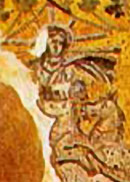
JC takes over from Apollo as the Sun God in his fiery chariot
3rd century, tomb mosaic, Rome


JC, with augur’s wand and legislator’s scroll, raises Lazarus 3rd century sarcophagus |

JC takes over from Apollo as the “Good Shepherd” 4th century, catacombs, Rome |

Good Shepherd Christ – 4th century AD Rome.

Good Shepherd Apollo – 6th century BC Athens.
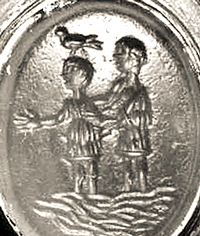
“JC the boy” is baptised by John. 4th-5th century gem (The Beazley Archive) |
Note the dove.
Long before the fable of Jesus the dove symbolised the sacred feminine (Astarte, Tanit, et al). By the 1st century the goddess had been marginalised and now the dove stood for the “spirit of God.”

JC dons his philosopher’s toga
4th century, Rome

Socrates – 5th century BC Athens

JC with short hair and beardless on engraved glass plate. 4th century, Linares (ancient Castulo), Spain |
Constantine again?

Notice that Jesus has his foot on the head of a fallen pagan god.
Propaganda in stone in the battle with the old gods!
JC takes over as teacher
4th century – Sarcophagus of Junius Bassus (Rome, 359 AD)
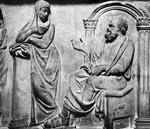
Greek philosopher as teacher.
Socrates – 5th century BC Athens.

Baptism of boyish 6th century Christ (Ivory, Egypt or Syria – British Museum)
Note: The River Jordan is personified (lower right).

4th century Antinous, with Cross in one hand – and the grapes of Dionysus in the other!
(Stele from Antinoopolis, Egypt.
Staatliche Museen, Berlin)
JC takes inspiration from a human sacrifice (Antinous)

6th/7th century Coptic Christ, Egypt
– note the grapes of Dionysus!
Clothed – but is that a family resemblance to Antinous ?!

JC, as Good Shepherd, wields his cross as a shepherd’s crook
5th century mosaic, tomb of Galla Placidia, Ravenna

A relaxed, well-fed JC stands, rather than hangs, from his cross.
5th century carved wooden panel, door of Santa Sabina, Rome.
Note that Jesus and the thieves stand in the orans pose, arms outstretched with palms up, a pose associated with prayer – and paganism.

JC, clean shaven young man, as Greek philosopher, moving in polite society, sporting Apollo’s sun ‘nimbus’ 6th century mosaic |
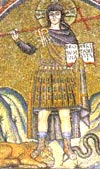
JC as soldier – this time carrying his cross like a lance, strutting about as a Roman conqueror
6th century mosaic, Archiepiscopal Chapel, Ravenna

JC changes philosopher’s toga for monk’s habit, grows a rabbi’s beard, gets older.
6th century, Mt Sinai Monastery

JC joins a frieze of Sun and Moon gods, held aloft by angels. One of the family?
6th-7th century, Church of Quintanilla de las Viñas (Burgos), Visigothic Spain.

JC, older and weary but not yet hung on a cross.
6th-7th century, Egypt (Coptic, Louvre)

Gold solidus issued in 692 by Byzantine Emperor Justinian II bears the image of a monkish Christ. 7th century, Byzantium |

In the West JC, beardless but now with distorted proportions, gets nailed to his cross. 7th century, Athlone, Ireland |

JC becomes a Frankish warrior, complete with Woden’s headdress, weapons and long penis!
7th century, France

JC loses his humanity, becomes solemn, stylised icon.
7th-8th century, catacombs, Rome
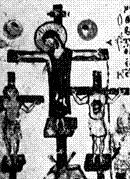
JC, hung up to die (but keeps his clothes on) 9th century, Chludoff Psalter |

JC, bearded yet still young, is the Christus Triumphans – on his cross but alive and without suffering. 10th century, Ireland (Monastery of Monasterboice) |

JC – older, uglier – just like the Church 11th century, Sinai Monastery (“Pantocrator”) Daphni, Greece |

JC – mean, sinister – just like the Church12th century, Russia (fresco) |

JC naked and limp on his cross 15th century manuscript (Aberdeen) |
Jesus becomes a Borgia!

1520
Altobello Melone paints Jesus on The Walk to Emmaus.

JC naked and limp on his cross 15th century manuscript (Aberdeen) |
The familiar image of Jesus Christ – modelled on the notorious Renaissance prince, in turns archbishop, cardinal, warlord and murderer. Dead at 31. At one point Cesare hired the services of Leonardo da Vinci (see Shroud).

JC in agony – Just like Christian Europe 16th woodcut (Durer) |

JC emaciated, dead 16th century, Netherlands (David Gerard) |

JC – On his knees, beaten, suffering – looks promising … 17th century, Spain |

That’s better – a tortured man for a tortured society …Christianity triumphs |
Sources:
William Dalrymple, From the Holy Mountain (Flamingo. 1998)
Michael Walsh, A Dictionary of Devotions (Burns & Oates, 1993)
Ian Wilson, Holy Faces, Secret Places (Doubleday, 1991)
Dom Robert Le Gall, Symbols of Catholicism (Editions Assouline, 1997)
Webb & Bower, The Illustrated Gospel of St John (1985)
Robin Keeley, Jesus 2000 (Lion, 1989)
R. E. Witt, Isis in the Ancient World (John Hopkins UP, 1971)
Keith Hopkins, A World Full of Gods (Free Press, 1999)
Timothy Ware, The Orthodox Church (Penguin, 1993)
- Preparing the Ground for Christianity – “Pick’n’Mix” in the Ancient World
- Christianity’s “civil war”: Arian vs Catholic – The Struggle for Power
- Hearts & Minds? – The “Conversion” of the Tribesmen
- 1000 Years of Carnage & Barbarity in the name of Christ
- The Papal Princes – Christian Lords of Hell on Earth
Within 50 years of Constantine, Christ gets an identical face!

JESUS
4th century mosaic, one of the earliest known depictions of Christ.
CONSTANTINE
4th century head of Emperor Constantine
Aging God
“The figure of Christ,
which had at first been youthful, becomes older from century to century… as the age of Christianity itself progresses.”
– Adolphe Didron, Christian Iconography.

Don’t I know that face…?
Those big, staring eyes, that dimpled chin.
The 4th century mosaic floor from a villa at Hinton St. Mary, Dorset, England, now in British Museum.
The mosaic covered two rooms, with the smaller area depicting Bellerophon killing the Chimera. The larger room was possibly for dining, meaning guests not only walked on their Christian god, but also ate above him!
In truth, the villa’s owner almost certainly chose designs that pleased him, both traditional pagan motifs and Christian fashions popularised by the imperial court.

Note that the Christ image faces away from the entrance porch – and is flanked by the pomegranates of Persephone!

Note that the Christ image faces away from the entrance porch – and is flanked by the pomegranates of Persephone!

Looks familiar…
Young, Antinous-like Christ (complete with exposed genitals) gets his holy bath
6th century Arian baptistery, Ravenna

Well Dead
Michelangelo Gets with the Program

Giving the finger
The hand of benediction from the god Sabazios – the Phrygian “Zeus” (6th century BC).
Worship of the god merged into the cult of Dionysus during the Hellenic period.
The ornate votive offering is covered in mystical symbols.
Early Christians were so taken by the awesome magic of finger gestures that they expropriated the trick for them-selves. It masquerades today as the “sign of the cross” or Holy Trinity.


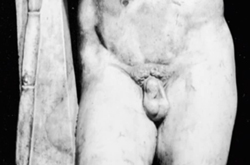
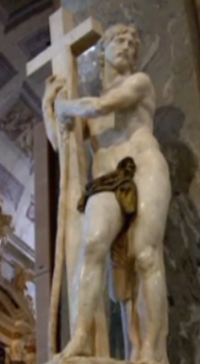
Lamb Chopped
At the close of the 8th century, Pope Hadrian I (772-795) confirmed the decrees of the 6th Synod of Constantinople held almost a century earlier and commanded that thereafter “the figure of a man should take the place of a lamb on the cross.”
It took Christianity eight centuries to develop the ubiquitous symbol of its suffering Savior.
For 800 years, its Christ on the cross had been a lamb.
But if a real flesh and blood Jesus had actually been crucified, why was his place on the cross so long usurped by a lamb?

‘Che Jesus’.
The Lord can be anything you want him to be.
